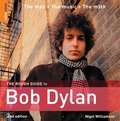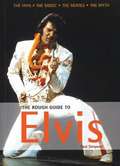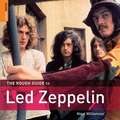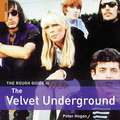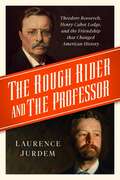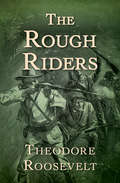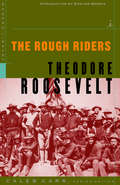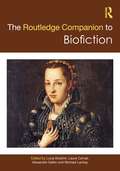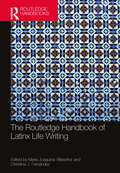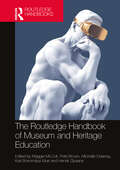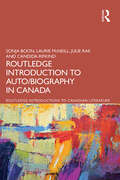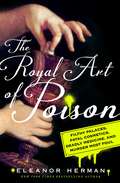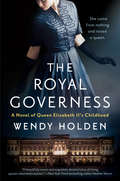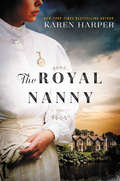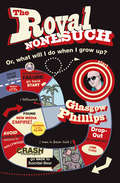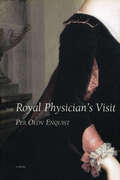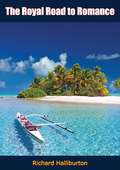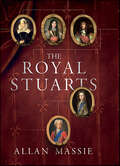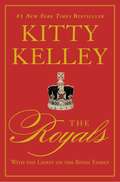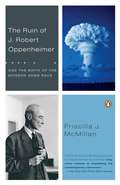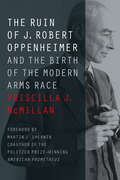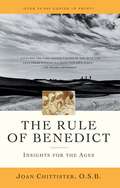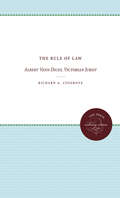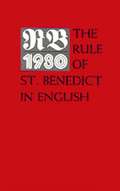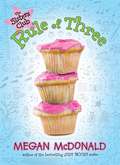- Table View
- List View
The Rough Guide to Bob Dylan
by Nigel WilliamsonBob Dylan is the ultimate singer-songwriter - revered, enigmatic and responsible for a staggering number of classic songs. This second edition of The Rough Guide to Bob Dylan demystifies the man and the music, exploring his life, his lyrics, and the legends that surrounded them. The Life: from Minnesota to Manchester, from the Albert Hall to the Never Ending Tour, The Music: the 50 greatest songs and the stories behind them, plus albums, bootlegs and compilations, The Movies: Dylan on screen and soundtracks, from Pat Garrett & Billy the Kid to No Direction Home, Dylanology: the wisdom of Bob, comic songs and curios, plus books, fanzines and websites.
The Rough Guide to Elvis
by Paul SimpsonJanuary 2005 was the 70th anniversary of Elvis Presley's birth. This new edition of the Rough Guide to Elvis is the most up-to-date guide on every aspect of The King, from his songs to his record collection, his cars to his costumes, from his birth to his mythic afterlife. The guide charts his life, the music, the 50 essential Presley songs, the collectables, the museums, a world tour of the essential Elvis sights - from Graceland to Germany - and the Icon - Elvis as king, star, image and myth.
The Rough Guide to Led Zeppelin
by Nigel WilliamsonRock legends Led Zeppelin remain a colossal music force with songs at once mystical, heavy, traditional and highly original. The Rough Guide to Led Zeppelin tells the story of the life and afterlife of this most extraordinary supergroup. Features include: The Story: from the first meeting of Plant and Page to the untimely death of John Bonham, detailing the magic, mayhem and excesses of the era. The Music: the band's fifty best songs unpicked, plus coverage of blues influences, bootlegs, solo careers, and the best Jimmy Page guitar solos and most outstanding Robert Plant vocals. The Passengers: profiles of collaborators and colleagues including Roy Harper and Mickie Most. The Cargo: Zeppelin films, places, myths and memorabilia, books, websites and the afterlife of 'Stairway to Heaven.' It's a whole lotta Zep . . . .
The Rough Guide to the Velvet Underground
by Peter HoganSporting shades and a feedback-heavy sounds, the Velvets straddled art and rock, changing popular music forever, and sowing the seeds for punk, grunge and thousands of counter-cultural four-chord wonders. The Rough Guide to The Velvet Underground explores: The Velvet Story: How Lou Reed, Sterling Morrison, John Cale and the others emerged from the New York scene, their successes and excesses and what happened to each in their solo years. Velvet Music: From their 1967 debut with Nico to their 1993 reunion with all the tales behind the tunes. Velvet Universe: Everybody who was anybody in the Velvet's world, taking in Andy Warhol, Edie Sedgwick, David Bowie, Delmore, Schwaretsz and Brian Eno. Velvet Goldmine: The Underground on screen, the Velvet's New York, clubs, influences, covers, websites and more.
The Rough Rider and the Professor: Theodore Roosevelt, Henry Cabot Lodge, and the Friendship that Changed American History
by Laurence JurdemEvoking the political intrigue of the Gilded Age, The Rough Rider and the Professor chronicles the extraordinary thirty-five-year friendship between President Theodore Roosevelt and Senator Henry Cabot Lodge of Massachusetts.Theodore Roosevelt was a uniquely gifted figure. A man of great intellect and physicality, the New York patrician captured the imagination of the American people with his engaging personality and determination to give all citizens regardless of race, color, or creed the opportunity to achieve the American dream. While Roosevelt employed his abilities to rise from unknown New York legislator to become the youngest man ever to assume the presidency in 1901, that rapid success would not have occurred without the assistance of the powerful New Englander, Henry Cabot Lodge. Eight years older than Roosevelt, from a prominent Massachusetts family, Lodge, was one of the most calculating, combative politicians of his age. From 1884 to 1919 Lodge and Roosevelt encouraged one another to mine the greatness that lay within each of them. As both men climbed the ladders of power, Lodge, focused on dominating the political landscape of Massachusetts, served as the future president&’s confidant and mentor, advising him on political strategy while helping him obtain positions in government that would eventually lead to the White House. Despite the love and respect that existed between the two men, their relationship eventually came under strain. Following Roosevelt's ascension to the presidency, T. R.&’s desire to expand the social safety net—while attempting to broaden the appeal of the Republican Party—clashed with his older friend's more conservative, partisan point of view. Those tensions finally culminated in 1912. Lodge's refusal to support the former president's independent bid for a third presidential term led to a political break-up that was only repaired by each man's hatred for the policies of Woodrow Wilson. Despite their political disagreements, Theodore Roosevelt and Henry Cabot Lodge remained devoted friends until the Rough Rider took his final breath on January 6, 1919.
The Rough Riders
by Theodore RooseveltTheodore Roosevelt’s bestselling memoir chronicling the 1st United States Volunteer Cavalry and its victory at San Juan Hill in the Spanish-American War. Yearning to join the fight for Cuban independence in the Spanish–American War, Theodore Roosevelt and Col. Leonard Wood formed the 1st United States Volunteer Cavalry. They enlisted a motley crew from all walks of life, from cowboys and frontiersmen to Ivy League graduates. These 1,250 men became known as the Rough Riders. After training in San Antonio, Texas, they set out for the tropical jungles of Cuba. As they grappled with hunger, malaria, and occasional defeat, their many battles with the Spanish Army culminated in the death-defying charge to victory at San Juan Hill. Through it all, Roosevelt kept a pocket diary in which he made daily entries about his experiences and the men who fought beside him. Imbued with his trademark vigor and certainty of purpose, Roosevelt’s firsthand account of this historic campaign paints a vivid picture of the rugged, independent spirit that came to define American heroism. This ebook has been professionally proofread to ensure accuracy and readability on all devices.
The Rough Riders: An Account Of The Experiences And Hardships Of The American Rough Riders (Modern Library War)
by Theodore RooseveltIn 1898, as the Spanish-American War was escalating, Theodore Roosevelt assembled an improbable regiment of Ivy Leaguers, cowboys, Native Americans, African-Americans, and Western Territory land speculators. This group of men, which became known as the Rough Riders, trained for four weeks in the Texas desert and then set sail for Cuba. Over the course of the summer, Roosevelt's Rough Riders fought valiantly, and sometimes recklessly, in the Cuban foothills, incurring casualties at a far greater rate than the Spanish. Roosevelt kept a detailed diary from the time he left Washington until his triumphant return from Cuba later that year. The Rough Riders was published to instant acclaim in 1899.Robust in its style and mesmerizing in its account of battle, it is exhilarating, illuminating, and utterly essential reading for every armchair historian and at-home general. The books in the Modern Library War series have been chosen by series editor Caleb Carr according to the significance of their subject matter, their contribution to the field of military history, and their literary merit.
The Routledge Companion to Biofiction (Routledge Literature Companions)
by Michael Lackey Lucia Boldrini Alexandre Gefen Laura CernatThe Routledge Companion to Biofiction provides readers with the history, origins, and evolution of this popular genre. Featuring contributions from leading scholars in the field, this authoritative collection foregrounds analyses of biofiction's core foundations through contemporary debates. The volume is organized into seven sections: Histories of biofiction; Theoretical reflections on biofiction; Biofiction, national models and (trans)national constructions; Biofiction as political intervention; Biofictional case studies; Activating lives: early modern women; and Authorial reflections. This groundbreaking collection features works that refine our understanding of the genesis and evolution of biofiction; theorize its unique and distinctive modes of signifying; reflect on its value for the future and social justice; chart new approaches for doing biofictional analysis; and offer insights from authors of biofiction into the creative process.This is the first collection to bring together the two main schools of interpreting biofiction – the Francophone and Anglophone – while also shedding light on biofictions in many languages, from or about many continents, and offering a platform to established and new voices alike. It will be essential reading for students as well as advanced scholars interested in biographical fiction.
The Routledge Handbook of Latinx Life Writing (Routledge Literature Handbooks)
by Maria Joaquina VillaseñorThe Routledge Handbook of Latinx Life Writing provides an in‑depth introduction to Latinx life writing, taking a historical approach to the study of a variety of key Latinx life writers, genres, and thematic concerns. This volume includes chapters on fundamental genres of Latinx life writing including memoir, autobiography, oral history, testimonio, comics and graphic texts, poetry of protest, and theatre to more fully depict the breadth, dynamism, and vibrancy of Latinx life writing. Latinx people continuously engaged in the empowering act of telling their stories and narrating their lives, producing writing that at various times and in various ways expressed their joy, expressed their rage and anguish, and ultimately, asserted their subjectivity all the while indelibly contributing to the American literary landscape.
The Routledge Handbook of Museum and Heritage Education (Routledge Handbooks on Museums, Galleries and Heritage)
by Michelle Delaney Pete Brown Maggie McColl Karl Borromäus Murr Henrik ZipsaneThe Routledge Handbook of Museum and Heritage Education is a practical reference guide that shows how museums, galleries and heritage sites can offer opportunities for successful visitor engagement.Defining museums as all cultural sites that interpret collections and spaces for public education, understanding, and enjoyment, this volume argues that museum education has a central role in the development of policies, practices, and research for engagement. Including contributions from experts across the globe, the volume shows how these sites can continue to offer unique opportunities for social, physical, emotional, and academic engagement that are much needed to inform and empower museum visitors internationally. It also demonstrates how museums, galleries, and heritage sites can be utilised for the betterment and sustainability of our world and the societies we live in. Combining rich theory with innovative practice, this book provides a comprehensive analysis of museum and heritage education today.The Routledge Handbook of Museum and Heritage Education will be of interest to academics, students, and professionals who are based in the fields of museum education, heritage, adult and community education, cultural studies, social studies, psychology, and tourism.
The Routledge Introduction to Auto/biography in Canada (Routledge Introductions to Canadian Literature)
by Julie Rak Candida Rifkind Sonja Boon Laurie McNeillThe Routledge Introduction to Auto/biography in Canada explores the exciting world of nonfiction writing about the self, designed to give teachers and students the tools they need to study both canonical and lesser-known works. The volume introduces important texts and contexts for interpreting life narratives, demonstrates the conceptual tools necessary to understand what life narratives are and how they work, and offers an historical overview of key moments in Canadian auto/biography. Not sure what life writing in Canada is, or how to study it? This critical introduction covers the tools and approaches you require in order to undertake your own interpretation of life writing texts. You will encounter nonfictional writing about individual lives and experiences—including biography, autobiography, letters, diaries, comics, poetry, plays, and memoirs. The volume includes case studies to provide examples of how to study and research life narratives and toolkits to help you apply what you learn. The Routledge Introduction to Auto/biography in Canada provides instructors and students with the contexts and the critical tools to discover the power of life writing, and the skills to study any kind of nonfiction, from Canada and around the world.
The Royal Art of Poison: Filthy Palaces, Fatal Cosmetics, Deadly Medicine, and Murder Most Foul
by Eleanor Herman"You’ll be as appalled at times as you are entertained." —Bustle, one of The 17 Best Nonfiction Books Coming Out In June 2018"A heady mix of erudite history and delicious gossip." —Aja Raden, author of StonedIn the Washington Post roundup, "What your favorite authors are reading this summer," A.J. Finn says, “I want to read The Royal Art of Poison, Eleanor Herman’s history of poisons."Hugely entertaining, a work of pop history that traces the use of poison as a political—and cosmetic—tool in the royal courts of Western Europe from the Middle Ages to the Kremlin todayThe story of poison is the story of power. For centuries, royal families have feared the gut-roiling, vomit-inducing agony of a little something added to their food or wine by an enemy. To avoid poison, they depended on tasters, unicorn horns, and antidotes tested on condemned prisoners. Servants licked the royal family’s spoons, tried on their underpants and tested their chamber pots. Ironically, royals terrified of poison were unknowingly poisoning themselves daily with their cosmetics, medications, and filthy living conditions. Women wore makeup made with mercury and lead. Men rubbed turds on their bald spots. Physicians prescribed mercury enemas, arsenic skin cream, drinks of lead filings, and potions of human fat and skull, fresh from the executioner. The most gorgeous palaces were little better than filthy latrines. Gazing at gorgeous portraits of centuries past, we don’t see what lies beneath the royal robes and the stench of unwashed bodies; the lice feasting on private parts; and worms nesting in the intestines. In The Royal Art of Poison, Eleanor Herman combines her unique access to royal archives with cutting-edge forensic discoveries to tell the true story of Europe’s glittering palaces: one of medical bafflement, poisonous cosmetics, ever-present excrement, festering natural illness, and, sometimes, murder.
The Royal Governess: A Novel of Queen Elizabeth II's Childhood
by Wendy HoldenIn "a beautifully woven and exquisitely detailed story of strong upstairs/downstairs women&” (Heather Morris, New York Times bestselling author of The Tattooist of Auschwitz) Sunday Times bestselling author Wendy Holden brings to life the unknown childhood years of one of the world&’s most famous figures, Queen Elizabeth II, and reveals the spirited young governess who made her the icon we love today. In 1933, twenty-two-year-old Marion Crawford accepts the role of a lifetime, tutoring the little Princesses Elizabeth and Margaret Rose. Her one stipulation to their parents the Duke and Duchess of York is that she bring some doses of normalcy into their sheltered and privileged lives. At Buckingham Palace, Windsor Castle and Balmoral, Marion defies stuffy protocol to take the princesses on tube trains, swimming at public baths, and on joyful Christmas shopping trips at Woolworth&’s. From her ringside seat at the heart of the British monarchy she witnesses twentieth-century history&’s most seismic events. The trauma of the Abdication, the glamour of the Coronation, the onset of World War II. She steers the little girls through it all, as close as a mother. During Britain&’s darkest hour, as Hitler&’s planes fly over Windsor, she shelters her charges in the castle dungeons (not far from where the Crown Jewels are hidden in a biscuit tin). Afterwards, she is present when Elizabeth first sets eyes on Philip. But being beloved confidante to the Windsors comes at huge personal cost. Marriage, children, her own views: all are compromised by proximity to royal glory. In this majestic story of love, sacrifice and allegiance, bestselling novelist Holden shines a captivating light into the years before Queen Elizabeth II took the throne.
The Royal Nanny: A Novel
by Karen HarperBased on a seldom-told true story, this novel is perfect for everyone who is fascinated by Britain's royal family--a behind the scenes look into the nurseries of little princes and the foibles of big princes.April, 1897: A young nanny arrives at Sandringham, ancestral estate of the Duke and Duchess of York. She is excited, exhausted--and about to meet royalty. . . .So begins the unforgettable story of Charlotte Bill, who would care for a generation of royals as their parents never could. Neither Charlotte--LaLa, as her charges dub her--nor anyone else can predict that eldest sons David and Bertie will each one day be king. LaLa knows only that these children, and the four who swiftly follow, need her steadfast loyalty and unconditional affection.But the greatest impact on Charlotte's life is made by a mere bud on the family tree: a misunderstood soul who will one day be known as the Lost Prince. Young Prince John needs all of Lala's love--the kind of love his parents won't...or can't...show him.From Britain's old wealth to the glittering excesses of Tsarist Russia; from country cottages to royal yachts, and from nursery to ballroom, Charlotte Bill witnesses history. The Royal Nanny is a seamless blend of fact and fiction--an intensely intimate, yet epic tale spanning decades, continents, and divides that only love can cross.
The Royal Nonesuch: Or, What Will I Do When I Grow Up?
by Glasgow PhillipsGlasgow Phillips published his debut novel Tuscaloosa at the tender age of twenty-four. The results were disastrous: encouraging reviews, translations, a paperback sale, a film option, and a Stegner Fellowship at Stanford. But over the next two years, as Phillips’s second novel unraveled and freelance journalism assignments ended in humiliation, a horrible, secret thought took hold in him: perhaps, just possibly, whatever talent he had was of the kind that would never be more than promise.Washed up as a "real” writer before he was thirty, Phillips went to Los Angeles and formed a company with his best childhood friend Jason McHugh, independent producer of Cannibal! The Musical and Orgazmo. The Royal Nonesuch is the story of Phillips’s rollercoaster ride through the twisted world of underground Hollywood and the funhouse of the Internet during the boom. Phillips builds a hilarious and poignant memoir, in the tradition of Augusten Burroughs and Sean Wilsey, from tales of promise and failure, family and madness, friendship and redemption, fame and infamy, and good old-fashioned hustling. It is a remarkable book; a brilliant portrait of a generation in all its foolish glory.
The Royal Physician's Visit
by Per Olov EnquistA handsome doctor stirs up scandal in the eighteenth-century Danish royal court in this “extraordinarily elegant and gorgeous novel” (Los Angeles Times).The Royal Physician's Visit magnificently recasts the dramatic era of Danish history when Johann Friedrich Struensee—court physician to mad young King Christian—stepped through an aperture in history and became the holder of absolute power in Denmark. His is a gripping tale of power, sex, love, and the life of the mind, and it is superbly rendered here by Sweden’s most acclaimed writer. A charismatic German doctor and brilliant intellectual, Struensee used his influence to introduce hundreds of reforms in Denmark in the 1760s and had a tender and erotic affair with Queen Caroline Mathilde, who was unsatisfied by her unstable, childlike husband. And yet, his ambitions ultimately led to tragedy. This novel, perfect for book clubs, is a compelling look into the intrigues of an Enlightenment court and the life of a singular man.“An enthralling fable of the temptations of power—and a surprisingly poignant love story,” —Time“Realized with a vividness and subtlety that place the book in the front ranks of contemporary literary fiction,” —The New York Times Book Review“The Swedish novelist’s method is to begin 10 years after Struensee’s fall, then retrace the “Struensee era,” as it came to be called, by probing the characters of four principal players—Christian, Guldberg, Struensee, and Queen Caroline Mathilde—each of whose perspectives, even the king’s, he makes intelligible and occasionally even sympathetic. A towering achievement,” —Booklist
The Royal Road to Romance: American's Most Dashing Adventurer Explores 1920s India (Travelers' Tales Classics Ser.)
by Richard HalliburtonTHE ROYAL ROAD TO ROMANCE in which a gay young romanticist goes laughing and beating and fighting his vagabond way into the glamorous corners of the world.Richly illustrated throughout.“Impetuous to utter recklessness, laughing at hardships, dreaming of beauty, ardent for adventure, Richard Halliburton has managed to sing into the pages of this glorious book his own exultant spirit of young and freedom.”—Chicago Post“The mad, exhilarating, and joyous spirit of Richard Halliburton’s Royal Road to Romance is the very incarnation of youth, with its horizons of rainbows and its sparkling, unquenchable, enthusiastic extravagances.”—Boston Transcript“This wild young American who recently conquered the unruly waters of the classic Hellespont writes as impetuously and as dramatically as he swims.”—Memphis Commercial Appeal“Richard Halliburton’s tale of travel and adventure is one of the most fascinating books of its kind ever written. It is a glorious story of the irresponsibility of youth, of dauntless spirit of the age, told with a captivating charm and a swing and a dash that take one’s breath away.”—Detroit News
The Royal Stuarts
by Allan Massie"Compelling...A masterly feat...A magnificent, sweeping, authoritative, warm yet wry history."--The Wall Street JournalIn this fascinating and intimate portrait of the Stuarts, author Allan Massie takes us deep into one of history's bloodiest and most tumultuous reigns. Exploring the family's lineage from the first Stuart king to the last, The Royal Stuarts is a panoramic history of the family that acted as a major player in the Scottish Wars of Independence, the Union of the Crowns, the English Civil War, the Restoration, and more. Drawing on the accounts of historians past and present, novels, and plays, this is the complete story of the Stuart family, documenting their path from the salt marshes of Brittany to the thrones of Scotland and England and eventually to exile. The Royal Stuarts brings to life figures like Mary, Queens of Scots, Charles I, and Bonnie Prince Charlie, uncovering a family of strong affections and fierce rivalries. Told with panache, this is the gripping true story of backstabbing, betrayal, and ambition gone awry.
The Royals (Large Print Book Ser.)
by Kitty KelleyBiography of the British royal family; includes new chapter.
The Ruin of J. Robert Oppenheimer and the Birth of the Modern Arms Race
by Priscilla McmillanIn a groundbreaking book that recasts the history of the Cold War, bestselling author Priscilla J. McMillan exposes, for the first time, the truth behind J. Robert Oppenheimer's 1954 trial on charges of violating national security. Drawing on newly declassified papers and extensive interviews, McMillan places Oppenheimer's opposition to development of the hydrogen bomb at the heart of the story--opposition that made him the victim of government officials who, conspiring with rival scientist Edward Teller, deceived President Eisenhower and trapped the enigmatic genius who had done more than anyone to build the atomic bomb. A chilling exposé of the McCarthy-era conspiracy that helped propel the East-West arms race, this is a spellbinding work of history.
The Ruin of J. Robert Oppenheimer: And the Birth of the Modern Arms Race (Johns Hopkins Nuclear History and Contemporary Affairs)
by Priscilla J. McMillanThis groundbreaking Cold War history reveals the government conspiracy to bring down America’s most famous scientist.On April 12, 1954, the nation was astonished to learn that J. Robert Oppenheimer was facing charges of violating national security. Could the man who led the effort to build the atom bomb really be a traitor? In this riveting book, Priscilla J. McMillan draws on newly declassified U.S. government documents and materials from Russia, as well as in-depth interviews, to expose the conspiracy that destroyed the director of the Manhattan Project.This meticulous narrative recreates the fraught years from 1949 to 1955 when Oppenheimer and a group of liberal scientists tried to head off the cabal of air force officials, anti-Communist politicians, and rival scientists, who were trying to seize control of U.S. policy and build ever more deadly nuclear weapons. Retelling the story of Oppenheimer’s trial, which took place in utmost secrecy, she describes how the government made up its own rules and violated many protections of the rule of law. McMilliam also argues that the effort to discredit Oppenheimer, occurring at the height of the McCarthy era and sanctioned by a misinformed President Eisenhower, was a watershed in the Cold War, poisoning American politics for decades and creating dangers that haunt us today.
The Rule of Benedict: Insights for the Ages
by Joan ChittisterBenedictine Sister and prominent author and speaker Joan Chittister contends that Benedictine spirituality is the most effective way to address the core issues of the 21st century: stewardship, relationships, authority, community, balance, work, simplicity, prayer, and spiritual and psychological development.
The Rule of Law: Albert Venn Dicey, Victorian Jurist (Studies in Legal History)
by Richard A. CosgroveSo commonplace has the term rule of law become that few recognize its source as Dicey's Introduction to the Study of the Law of the Constitution. Cosgrove examines the life and career of Dicey, the most influential constitutional authority of late Victorian and Edwardian Britain, showing how his critical and intellectual powers were accompanied by a simplicity of character and wit. Dicey's contribution to the history of law is described as is his place in Victorian society.Originally published 1980.A UNC Press Enduring Edition -- UNC Press Enduring Editions use the latest in digital technology to make available again books from our distinguished backlist that were previously out of print. These editions are published unaltered from the original, and are presented in affordable paperback formats, bringing readers both historical and cultural value.
The Rule of St. Benedict in English
by Timothy FryRule for monastic life by St. Benedict of Nursia, 6th century.
The Rule of Three (The Sisters Club)
by Megan McdonaldThe play's the thing when sibling rivalry takes center stage in a funny, spot-on, all-new Sisters Club story by the inimitable creator of Judy Moody. Alex has always been the Actor-with-a-capital-A in the Reel family, and middle-sister Stevie has always been content behind the scenes. But when the school play turns out to be a musical, Stevie (the natural-born singer of the family), decides that she may just be tired of being the Sensible One. Maybe, for once, she'd like to be the one in the spotlight! Alex isn't so keen on vying for the same role as her younger sister, however, and soon the dueling divas -- with little sister Joey egging them on -- are engaged in a fierce competition to find out who's got what it takes to play the Princess. Has Stevie broken the rules by going for what she wants -- or will it be Alex who hands down the biggest betrayal of all?
